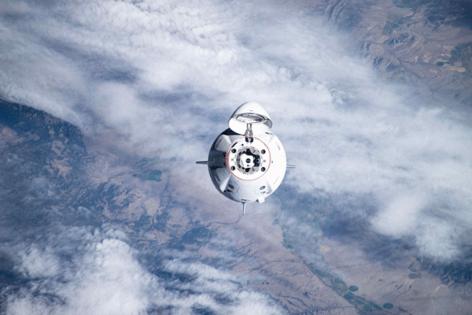SpaceX Dragon on way to space station with cargo, new reboost capability
Published in Science & Technology News
A SpaceX Dragon spacecraft is headed for its 50th rendezvous with the International Space Station, bringing cargo and a new reboost capability after having launched from the Space Coast early Sunday.
A Falcon 9 rocket lifted off from Cape Canaveral Space Force Station’s Space Launch Complex 40 at 2:45 a.m. on the CRS-33 mission, the 33rd resupply flight to the station, with a spacecraft filled with more than 5,000 pounds of supplies.
The first-stage booster for the mission flew for the seventh time and made a recovery landing downrange on the droneship A Shortfall of Gravitas, stationed in the Atlantic.
Unlike other flights, this Dragon will stay docked to the station for more than four months because of a newly installed ability to propel the station to higher altitudes.
Located in the trunk of the Dragon is an independent propellant system to fuel two Draco engines that will help sustain the lab’s altitude beginning in September and continuing through fall. This is a full demonstration, although the Dragon on CRS-31 in November 2024 did a smaller test of the capability.
Normally, Russia is responsible for all of the reboost maneuvers, using its Progress cargo spacecraft docked on their side of the station. While NASA’s other commercial resupply provider, Northrop Grumman, has in the past also used its Cygnus module for minor altitude adjustments, this marks the first time Elon Musk’s company will be relied on for operational boost capability.
It’s part of NASA’s plans to eventually decommission the station, which has been continuously occupied by humans since November 2000 but is slated to begin its end run after 2030.
For that, the station will need fuel reserves, and using the cargo Dragon for now will help build up some of those reserves instead of relying on the Progress spacecraft of the Russians.
SpaceX also has a contract to build out a deorbit vehicle that will use similar architecture to Dragon to assist the station on its trip back to burn up in Earth’s atmosphere and come down somewhere over the Pacific.
Dragon will arrive to the station early Monday expected to dock autonomously at 7:30 a.m. to the forward port of the station’s Harmony module.
It will be parked next to the Crew Dragon Endeavour, which arrived with the Crew-11 replacement crew earlier this month, with both expected to remain docked until the cargo Dragon departs in December.
The first cargo Dragon to dock with the station occurred in 2012, while the first crewed version docked in 2020. SpaceX has flown 32 previous cargo missions with the spacecraft in addition to 11 rotational crew replacement missions on top of both an uncrewed and crewed test flight of Crew Dragon and four private missions for Axiom Space that have all docked.
For this mission, in addition to supplies for the seven astronauts and cosmonauts on board the station, it brings a spate of new science and research.
On board are experiments including bone-forming stem cells for studying bone-loss prevention, materials for 3D print medical implants aimed at repairing nerve damage and bioprinted liver tissue to study blood vessel development in microgravity.
“Commercial resupply missions to the International Space Station deliver science that helps prove technologies for Artemis lunar missions and beyond,” said acting NASA Administrator Sean Duffy. “This flight will test 3D printing metal parts and bioprinting tissue in microgravity – technology that could give astronauts tools and medical support on future moon and Mars missions.”
_____
©2025 Orlando Sentinel. Visit orlandosentinel.com. Distributed by Tribune Content Agency, LLC.







Comments